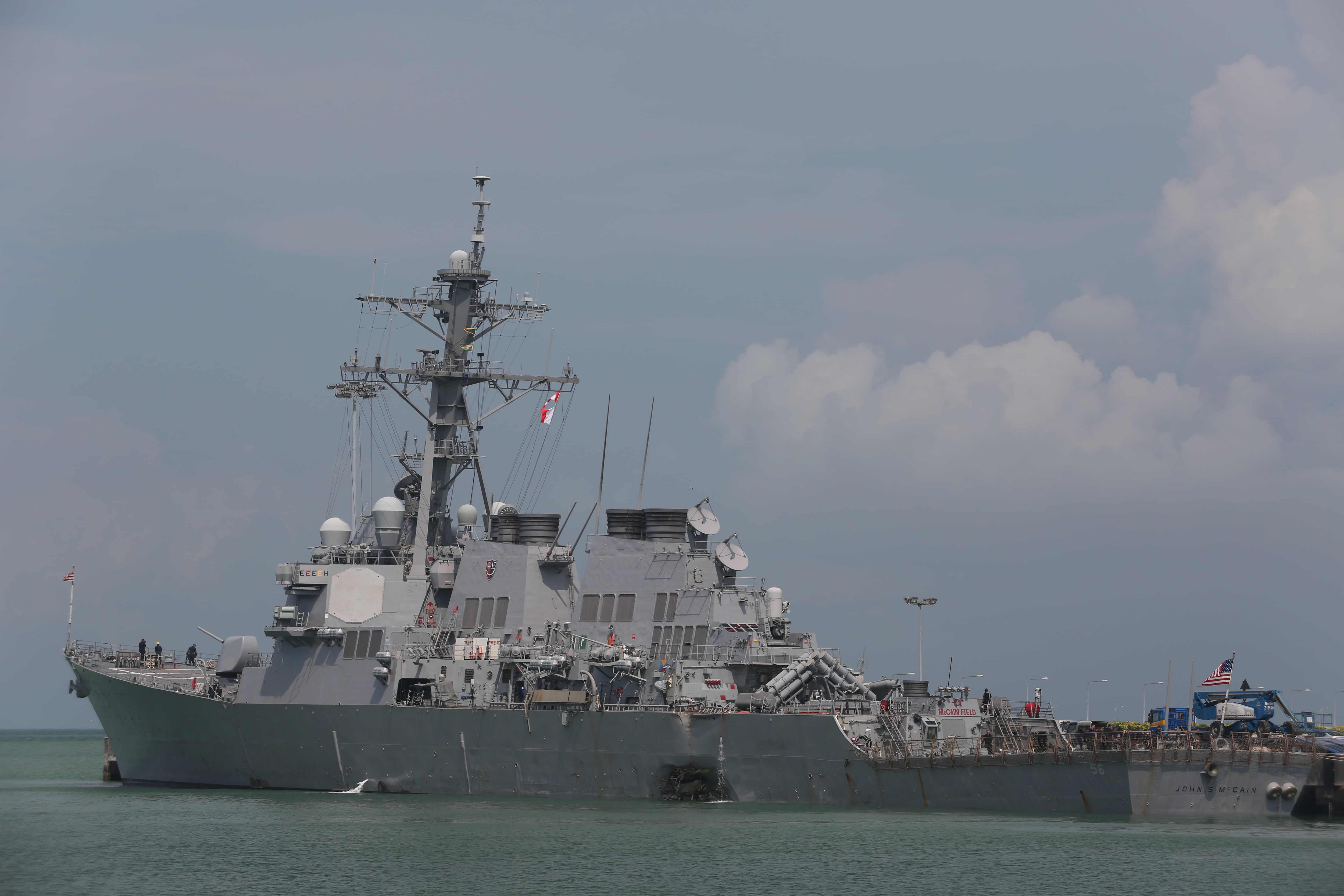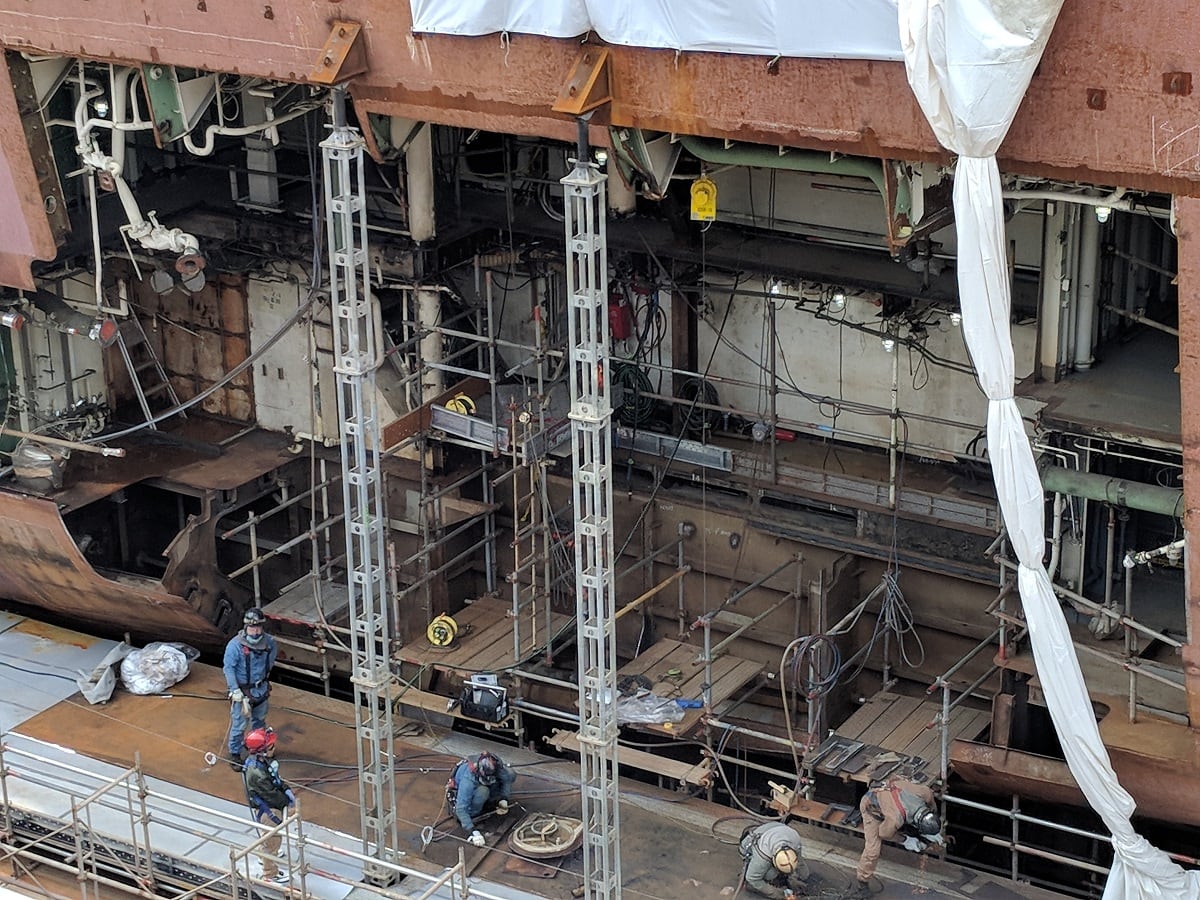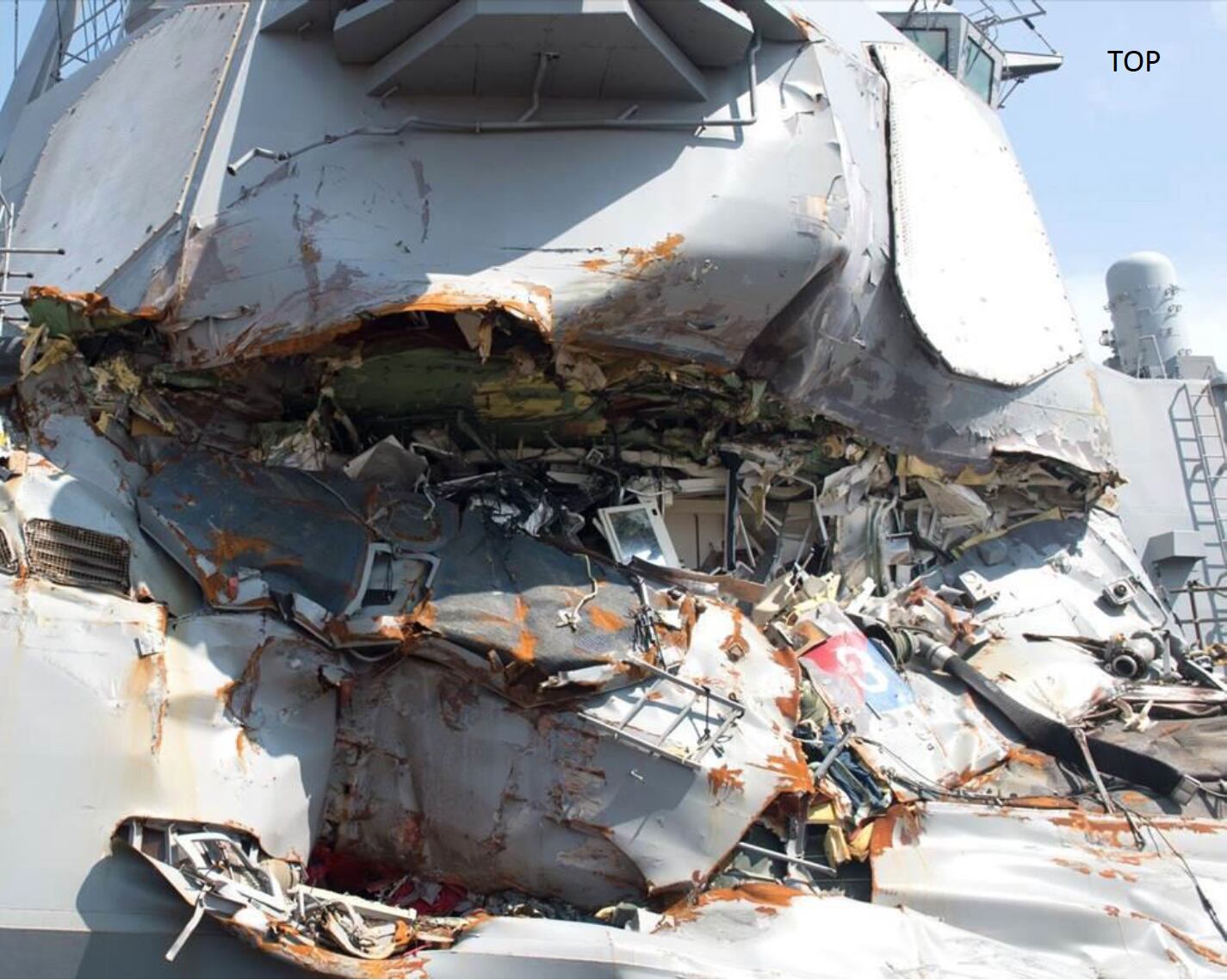YOKOSUKA, JAPAN ― The destroyer John S. McCain looks nothing like the battered wreck that limped into Changi Naval Base in August after its collision with a tanker more than twice its size.
It’s now up on blocks in dry dock at Fleet Activities Yokosuka, crawling with Japanese yard workers. The yawning hole punched through its hull by the bulbous bow of the Alnic MC has been neatly trimmed. The twisted metal, frayed wiring and shattered piping have all been ripped out, replaced with temporary supports and scaffolding.
Seven months have passed since 10 of McCain’s sailors were killed in a preventable collision, a loss made all the more shocking by the fact that it came just a few weeks after a collision between the destroyer Fitzgerald and a container ship claimed seven lives. While much work and many months lie ahead before McCain will go back in the water and on patrol in the Pacific, the wound in her port side is being healed.
Seventh Fleet is healing as well.
After enduring tragedy ― and upheaval at the upper echelons of command ― change has started to take root in Yokosuka under new leaders. Interviews with sailors, senior leaders, commanding and executive officers and the Fleet’s top officer, show a different 7th Fleet than the one that sailed into the disastrous summer of 2017.
In the wake of the accidents, the Navy’s Pacific-based command structure saw a shake-up with little precedent in the history of the service. The Navy fired the head of 7th Fleet, Vice Adm. Joseph Aucoin, the first time a fleet commander had been fired since World War II. But by the end of the spree, the Reagan Carrier Strike Group Commander, the head of the Yokosuka-based Destroyer Squadron 15, and the head of Commander Naval Surface Force Pacific had all been forced out.
The Pacific Fleet commander, Adm. Scott Swift, also announced his retirement after being passed over for nomination to the head of U.S. Pacific Command.
With a slew of new leaders and structures, 7th Fleet is moving out on new practices for readying ships and their crews, as well as how the ships operate at sea. From the top of the fleet to the deck plates, a small and hard-hit community is effecting a course correction that all hope will avoid another senseless loss of life, create stability in the schedule for sailors assigned there, and make 7th Fleet once again the razor-sharp tip of the Navy’s spear.
This account is based on more than two dozen interviews over four days, focusing on the changes since the accidents with the Navy’s Japan-based ships.
RELATED

Learning to say ‘No’
Led by Vice Adm. Phil Sawyer, the ships that remain to carry on the fight are being put into a strict schedule -- one that eschews the mitigation strategies central to declining standards discovered in the wake of the collisions. Seventh Fleet’s ships are being put through a system more akin to their sister ships in the United States: A maintenance phase for major shipyard repairs, a then a basic and advanced phase for training ahead of operations.
“Everybody is focused on doing the same thing and that is to make sure these ships are ready to go do what the Nation asks them to do,” Sawyer said in an interview with Defense News. “Everyone is bore-sighted on that, whether that’s the training side of that or the maintenance side of that.”
“We all recognize that sometimes maintenance doesn’t go as planned. Or in the training the phase, instead of taking two weeks, it may take three. So, the allegiance that I have to them is, within my authority, I’m going to give you the time to fix those things that need to be fixed and to get the training you need to go out and do the mission.”
To get 7th Fleet units trained, certified and ready for operations, the Navy has canceled the controversial risk assessment management plans that ran amok during the lead-up to last summer.
In the United States, ships earn certifications prior to deployment in everything from seamanship and navigation to proper employment of its combat systems to damage control. But in Japan, ships are always considered deployed so certifications must be kept current through revolving recertification checks built into a demanding operational schedule.
Overseen by Commander Naval Surface Force Pacific, Navy leaders were waiving ship training certifications ahead of patrols and operational commitments at an alarming rate. The practice became so widespread that overall ship certification rates declined between 2014 and 2016 from 93 percent certified to 62 percent.
The widespread use of the so-called RAMPs played a key role in the early exit of former CNSP head Vice Adm. Thomas Rowden. Defense News was the first to report on widespread use of this practice in 7th Fleet.
RELATED

The net result of the RAMPs was to run 7th fleet into a readiness ditch that will take months to dig out of. According to recent Navy testimony, this has led to a reduction in the overall availability of those ships for operations.
The chief of naval operations’ head of operations, plans and strategy told a congressional panel mid-March that since the accidents, the Navy has moved to ensure that all 7th Fleet ships are trained and ready to perform their missions.
“As you would expect, these actions have reduced the operational availability of our Japan-based ships in the short run as they undergo a rigorous recertification process,” Vice Adm. Woody Lewis told the readiness subcommittee of the House Armed Services Committee.
The recertification and retraining of the ships in Japan, as well as the reduced availability, will last for some months, Lewis continued.
“I expect that we will be passed this initial bow wave by late spring this year,” he said. “Full implementation of the new processes will take some time, but the end result will be a more ready, more capable, and more lethal Navy.”
The Navy’s new-found willingness and ability to say “no” to operational tasking is, without a doubt, tied to the accidents last summer, said Bryan Clark, a retired submarine officer and analyst with the Center for Strategic and Budgetary Assessments.
“It’s a great point to say that the Navy is saying ‘no’ now, and clearly what’s changed is these accidents,” Clark said.
Telling combatant commanders and the Joint Staff that ships were unavailable for tasking because of readiness concerns isn’t anything new for the Navy’s top brass, Clark continued. It just hasn’t been a very successful strategy. Until the deaths of 17 sailors, and the loss of three ballistic missile defense assets -- the cruiser Antietam was until late last year sidelined due to a grounding near Fleet Activities Yokosuka -- top defense officials were loathed to give up Navy capabilities.
“The Navy has wanted to do this for a while and it has been trying in various ways to reduce [operational tempo],” he said. “I think for the Secretary of Defense and the Joint Staff, it’s a lot clearer to them what’s at stake when you start to spread the Navy too thin.”

Becoming predictable
Key to the Navy’s new-found ability to say “no” will be crafting and sticking to a force generation model similar to the one employed by ships in the Continental United States.
Prior to the accidents, the widespread use of RAMPs had undermined any semblance of a force generation model for ships in Yokosuka. The Comprehensive Review executed by Fleet Forces Command, dedicated a whole section to the degradation of the kind of scheduling discipline that ensures Navy ships and their crews get the kind of training and maintenance required.
“The data indicate the assumptions underpinning the Yokosuka-based ships force generation model, such as duration of maintenance periods, had changed to the point that the intended model could not be executed,” the review found. “Additionally, execution of the RAMP process for these expired certifications had become an administrative acknowledgement of the expired certifications without true evaluation of the associated risk or development of meaningful mitigating actions.”
The review outlined a worsening readiness situation that correlated with an uptick in demand. Between the years 2015 and 2016, 7th Fleet ships saw a nearly 40 percent increase in days at sea, shooting up from an average of 116 days to 162 days.
The RAMPs system compounded the issue because, despite nearly every ship in Yokosuka having at least one expired certification, the mitigation plan in place made the ship look available for tasking even without its full lineup of certifications.
RELATED

And leaders in 7th Fleet allowed the situation to go without basic oversight, according to the review. Between November 2016 and the Fitzgerald collision in June 2017 7th Fleet failed to hold even one schedule planning conference to match up demands with trained and ready ships.
“As data was indicating a decline in readiness, higher headquarters did not recognize the aggregate risk of the pace of operations and did not take action to correct the imbalance between the generation and employment of Japan-based forces,” the review concluded.
As the full picture of the readiness decline and the widespread use of dubious mitigation strategies came to light after the John McCain collision, PACFLT Commander Swift stood up the Naval Surface Group Western Pacific. The group was to serve as both oversight and advocate for training and readiness of 7th Fleet’s ships. If a ship’s not ready for deployment, it’s their job to make it known up the chain of command.
Now the new operation, with a staff of more than 50 members, is being stood up and overseeing the new operation, still a few weeks away from an official ribbon-cutting ceremony, is Capt. Richard Dromerhauser. He’s a former Fitzgerald skipper who was most recently the head of the destroyer squadron in the Europe-based 6th Fleet based in Rota, Spain.
The group is slated to transfer to the control of CNSP in the coming weeks and will serve as SURFPAC’s representative in Japan, playing a direct role in readiness matters. The group will also serve to keep 7th Fleet honest about maintaining its force generation model going forward.
“Ultimately, we want to make sure our sailors have the confidence in their equipment and their team, the competence to operate these incredible ships and the ability to go out and be as lethal a force as we are,” Dromerhauser told Defense News. “There was never a question about the abilities of the individual sailors. This is about getting them the stability and rigor in a schedule.”
On a white board in his conference room, Dromerhauser sketched out the schedule that is serving as a working model for how ships in Yokosuka will deploy in the future. The way it’s working today is this:
The ships will rotate through a 24-month cycle that starts with a six-month maintenance availability for depot repairs and training. Then the ships go into an 18-week dedicated training period, followed by another month-long maintenance availability, then into an operations cycle.
During the second year things get heavier. The ship will be available for operations during all but 15 weeks, with short maintenance and training periods blocked in. All told, the schedule blocks out about 40 percent of a two-year cycle for training and maintenance and 60 percent of the time when the ship is available for operations.
“We are refining those times now, this is an iterative process,” Dromerhauser said. “What this does is give you a protected time to do maintenance, modernization gets added in there as prescribed by the [type commander], and then you start getting to these points where the availabilities don’t run long because we have so much work to do to be completely operational.”
The more rigorous force-generation model will also give shore-based training personnel, such as the Afloat Training Group, dedicated time to conduct training rather than working around a constantly shifting schedule, Dromerhauser said.
The factors that caused the Fitzgerald and McCain accidents are hard to pin directly to readiness shortfalls, but there is no question that the picture of readiness in 7th Fleet that emerged in the wake of those accidents was bleak.
For Sawyer, tasked with rebuilding a surface fleet that saw three of its ships sidelined because of accidents in 2017, getting the ships on a predictable, balanced schedule is key to restoring the readiness that drained away under unrelenting demands.
“I also say often that as we know both collisions were preventable – It was tragic,” Sawyer said. “Those seventeen deaths weigh on us all.
“So, our work is to make sure that we’ve identified the proper things, to correct issues and the corrective actions we’ve put in place are to prevent those going into the future. I think we are well down that path but it requires constant attention.”
Check back for Part II where Defense News talks with the waterfront to see what changes sailors and officers are seeing in the wake of last summer.
David B. Larter was the naval warfare reporter for Defense News.




